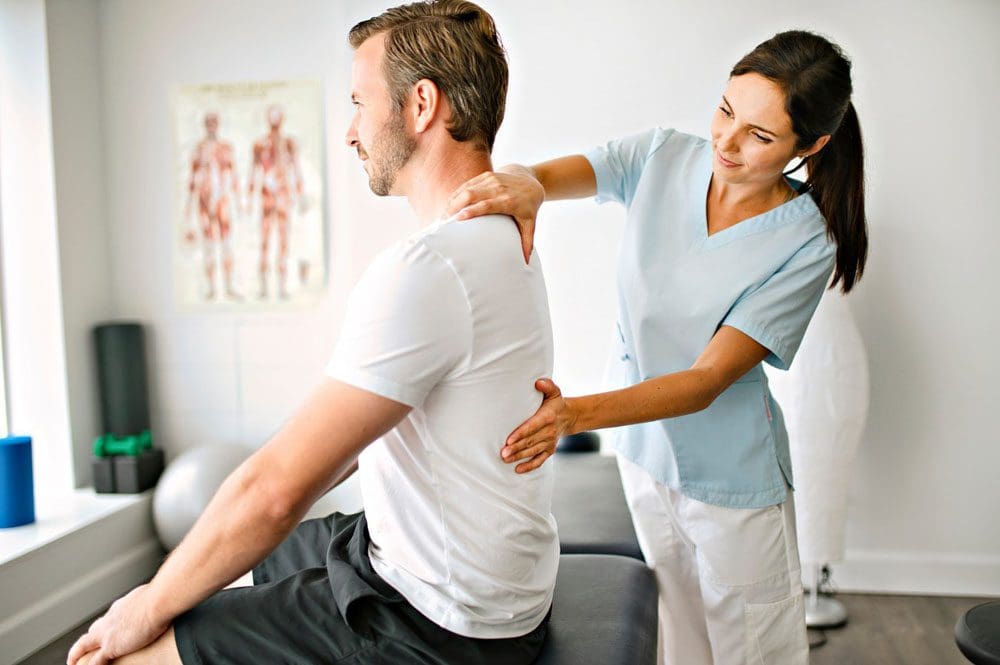Aging Arthritis: How the body changes as the years go by is determined by an individual’s diet, physical activity/exercise, genetics, stress levels, sleep patterns, and self-care. As the body ages, natural degeneration from everyday wear and tear will present. The focus is on understanding how age-related degeneration can affect the body and what to do to prevent and treat it.

Contents
Aging Arthritis
Arthritis refers to joint inflammation and is the fundamental cause of various disorders that include:
- Osteoarthritis
- Fibromyalgia
- Infectious arthritis
- Gout – metabolic arthritis
- Rheumatoid arthritis
- Lupus
- Childhood arthritis
Inflammation is just one symptom usually accompanied by swelling, pain, stiffness, immobility, and loss of function.
Osteoarthritis
- The most common type of arthritis is osteoarthritis, where the cartilage within joints begins to break down, and the bones begin to reshape.
- It’s known as degenerative joint disease/wear and tear arthritis.
- The hands, hips, and knees are the most commonly affected joints.
- These changes often develop slowly but worsen if not treated.
- Symptoms include intense pain, stiffness, and swelling.
Fibromyalgia
- Fibromyalgia is a condition that causes pain in various areas of the body, sleep problems, and fatigue.
- Individuals with fibromyalgia can be more sensitive to pain sensations.
- Treatments and management plans are available to help ease symptoms and restor function.
Infectious Arthritis
- Infectious arthritis or septic arthritis is caused by an infection in the joints.
- Bacteria from another area of the body can invade a joint or the fluid surrounding it.
- Bacteria can enter the body from open wounds, injections, or surgery.
- Infectious arthritis is usually only present in one joint.
- Staphylococcus aureus is a bacteria that lives on healthy skin and is the cause of most infectious arthritis cases.
- A virus or fungus can also generate arthritic inflammatory symptoms.
Gout
- Gout is a common type of arthritis that causes inflammation and pain.
- It usually only affects one joint, most commonly the big toe joint.
- Symptoms can intensify, known as flares, and other periods with no symptoms, known as remission.
- Recurrent gout episodes can degenerate into gouty arthritis, a more serious form of arthritis.
Rheumatoid Arthritis
- Rheumatoid arthritis is an autoimmune and inflammatory disease in which the immune system attacks healthy cells, causing inflammation.
- Rheumatoid arthritis attacks numerous joints simultaneously, specifically in the hands, wrists, and knees.
- Rheumatoid arthritis causes the joint lining to become inflamed and starts to damage nearby tissues.
- Tissue damage that is severe or chronic enough can cause pain, balance problems, and visible deformities.
- Rheumatoid arthritis can also affect organs, like the lungs, heart, and eyes, by causing inflammation.
Lupus
- Lupus is an autoimmune disease that affects various body systems.
- An autoimmune disease is when the immune system mistakes its tissues for bacterial, viral, or fungal intruders and attacks them.
- Lupus symptoms can be vague, making the disease hard to diagnose.
- The disease is known as the great imitator because symptoms can mimic other diseases.
- Symptoms range from mild to life-threatening.
- Seeing a rheumatologist is recommended, as they are specialists that can diagnose and treat arthritis, lupus, and other joint-related diseases.
Childhood Arthritis
- Arthritis in children is known as juvenile or childhood arthritis.
- Juvenile idiopathic arthritis/juvenile rheumatoid arthritis is the most frequent form.
- The condition can cause long-term joint damage that can lead to disability.
Aging Arthritis and Chiropractic Care
Chiropractic care is recommended for the treatment of any form of arthritis. Chiropractic care can work with other therapies to reduce swelling and inflammation, alleviate pain, and improve mobility and flexibility.
- A chiropractor will utilize body imagery before beginning treatment.
- Imaging gives insight into the condition of the joints, and the visual, combined with a self-report from the individual, allows the chiropractor to create a personalized treatment plan.
- Once a chiropractor has identified which techniques the body can handle, treatment will commence that can include:
- Therapeutic massage
- Percussive massage
- Ultrasound
- Electrotherapy
- Low-level cold laser therapy
- Infrared heat
A chiropractor’s objective is to rebalance, realign and strengthen the body, relieve pressure or stress at the junction of the joints, and expedite healing and rehabilitation.
LLT Laser Therapy
References
Abyad, A, and J T Boyer. “Arthritis and aging.” Current opinion in rheumatology vol. 4,2 (1992): 153-9. doi:10.1097/00002281-199204000-00004
Chalan, Paulina, et al. “Rheumatoid Arthritis, Immunosenescence and the Hallmarks of Aging.” Current aging science vol. 8,2 (2015): 131-46. doi:10.2174/1874609808666150727110744
Goronzy, Jorg J et al. “Immune aging, and rheumatoid arthritis.” Rheumatic diseases clinics of North America vol. 36,2 (2010): 297-310. doi:10.1016/j.rdc.2010.03.001
Greene, M A, and R F Loeser. “Aging-related inflammation in osteoarthritis.” Osteoarthritis and cartilage vol. 23,11 (2015): 1966-71. doi:10.1016/j.joca.2015.01.008
Sacitharan, Pradeep Kumar. “Ageing and Osteoarthritis.” Sub-cellular biochemistry vol. 91 (2019): 123-159. doi:10.1007/978-981-13-3681-2_6
Professional Scope of Practice *
The information on "Aging Arthritis: El Paso Back Clinic" is not intended to replace a one-on-one relationship with a qualified health care professional or licensed physician and is not medical advice. We encourage you to make healthcare decisions based on your research and partnership with a qualified healthcare professional.
Blog Information & Scope Discussions
Welcome to the wellness blog of El Paso Back Clinic, where Dr. Alex Jimenez, DC, FNP-C, a board-certified Family Practice Nurse Practitioner (FNP-C) and Chiropractor (DC), presents insights on how our team is dedicated to holistic healing and personalized care. Our practice aligns with evidence-based treatment protocols inspired by integrative medicine principles, similar to those found on dralexjimenez.com, focusing on restoring health naturally for patients of all ages.
Our areas of chiropractic practice include Wellness & Nutrition, Chronic Pain, Personal Injury, Auto Accident Care, Work Injuries, Back Injury, Low Back Pain, Neck Pain, Migraine Headaches, Sports Injuries, Severe Sciatica, Scoliosis, Complex Herniated Discs, Fibromyalgia, Chronic Pain, Complex Injuries, Stress Management, Functional Medicine Treatments, and in-scope care protocols.
Our information scope is limited to chiropractic, musculoskeletal, physical medicine, wellness, contributing etiological viscerosomatic disturbances within clinical presentations, associated somato-visceral reflex clinical dynamics, subluxation complexes, sensitive health issues, and functional medicine articles, topics, and discussions.
We provide and present clinical collaboration with specialists from various disciplines. Each specialist is governed by their professional scope of practice and their jurisdiction of licensure. We use functional health & wellness protocols to treat and support care for the injuries or disorders of the musculoskeletal system.
Our videos, posts, topics, subjects, and insights cover clinical matters, issues, and topics that relate to and directly or indirectly support our clinical scope of practice.*
Our office has reasonably attempted to provide supportive citations and has identified the relevant research studies or studies supporting our posts. We provide copies of supporting research studies available to regulatory boards and the public upon request.
We understand that we cover matters that require an additional explanation of how they may assist in a particular care plan or treatment protocol; therefore, to discuss the subject matter above further, please feel free to ask Dr. Alex Jimenez, DC, APRN, FNP-BC, or contact us at 915-850-0900.
We are here to help you and your family.
Blessings
Dr. Alex Jimenez, DC, MSACP, APRN, FNP-BC*, CCST, IFMCP, CFMP, ATN
email: coach@elpasofunctionalmedicine.com
Licensed as a Doctor of Chiropractic (DC) in Texas & New Mexico*
Texas DC License # TX5807
New Mexico DC License # NM-DC2182
Licensed as a Registered Nurse (RN*) in Texas & Multistate
Texas RN License # 1191402
ANCC FNP-BC: Board Certified Nurse Practitioner*
Compact Status: Multi-State License: Authorized to Practice in 40 States*
Graduate with Honors: ICHS: MSN-FNP (Family Nurse Practitioner Program)
Degree Granted. Master's in Family Practice MSN Diploma (Cum Laude)
Dr. Alex Jimenez, DC, APRN, FNP-BC*, CFMP, IFMCP, ATN, CCST
My Digital Business Card








